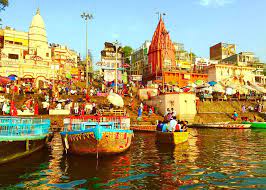
Varanasi
Even from the distance across the entire land I could pick her out with her daughters in the crowd of villagers that waited to see them off. Fear was painted across her face now that the tremendous moment was here. She did not fear for herself, she never had – but she did for her three daughters who sat there pale, lonely with worry on their faces in the corner of their small hut in Varanasi. The three of them sat there with sagged shoulders and tensed faces. Though they were wearing colourful dupattas wrapped innocently around their heads, deep gloom filled their eyes that made them seem desperately ill, as they feared they yet might not be allowed to go.
Fear had never left them ever since the black days of the blitzkrieg when the Afghan army roared through the quiet midnight of the Varanasi village. Ever since that night when the soulless men of Afghan killed their husbands the terrible fear had been with them.
Back in 1761, Manikpur was a small village near Varanasi settled in a calm and peaceful atmosphere. Three sisters were travelling to Manikpur, their native place, where their widowed mother lived. Their husbands were soldiers in the Maratha army who went to fight against Ahmad Shah Abdali, the leader of the Afghans. The battle lasted for two months which ultimately resulted in the defeat of the Marathas. The three soldiers fought bravely but were slaughtered by the Afghan army. The three poor women were in great shock at their husband’s deaths.The village had demanded her daughters to be Sati. However, she had fought ferociously to stop them.
Through all these bleak years I watched her from afar, a tiny, unquenchable flame burning steadily, her will to protect her beloved three daughters inexhaustible. She did the work of numerous women, fighting against religious places to the king’s palace, across the ruined land, suffering indignities without flinching.
And finally, after a lot of struggle she won her battle in freeing the three women from Sati. However, she did not stop there. She fought for their lives against the grips of widowhood and adorned her daughters in colourful clothes and jewellery.
Even from the distance across the entire land I felt the leap of victory in her heart. Even from a distance I felt her joy and her surge for reformation, her undying desire for freedom, for a chance to start anew.
And at last when the Brahmo Samaj allowed her daughters to migrate to West Bengal I could see the tears of happiness in their eyes.
The woman sat with fear, waiting for their names to be called out. And even from here I could see the sheer strength of their wiry body as they carried themselves up, whispering, praying to
God for their new lives. They knew, reaching their destination meant life. West Bengal meant life.
And the three women made it. They looked back to face the sad land they had left behind. I watched them from here as they came closer and closer on the cart. How tenderly they were looking down through their red, orange and green veils. Their faces were seen. Seen with minimum lumps of jewels but jewels of respect and freedom. And at last, when the Bengal skyline loomed out of the morning mist and the moment was at hand, I saw them timidly, filled with awe, walking down the cart to their new home. Rajnagar Kandali place of Raja Ram Mohan Roy. And behind them lay the black years, years lighted only by the flame which leaped and blazed within the heart of their mother.
By: yaksh dharod
Write and Win: Participate in Creative writing Contest & International Essay Contest and win fabulous prizes.


